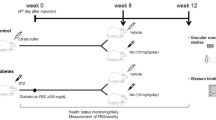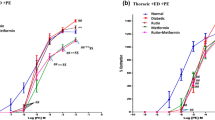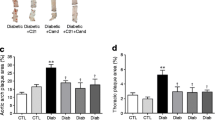Abstract
Background
Previous reports showed conflicting results regarding the treatment effects of statin on Diabetes mellitus (DM). We investigated how treatment with high dose of atorvastatin affects the impaired vascular function in diabetic rats.
Methods
Atorvastatin (80 mg/kg/day, oral gavage, 4 weeks) or its vehicle was administered to male control or streptozotocin (STZ)-induced diabetic rats. Aortic segments were used to investigate the vascular reactivity, protein expression of cyclooxygenase-2 (COX-2) and nicotinamide adenine dinucleotide phosphate oxidase (NADPH oxidase) 1 (NOX1) and superoxide anions levels.
Results
Atorvastatin treatment did not affect glycemia levels. In diabetic rats, the vascular reactivity to phenylephrine increased compared with controls and the atorvastatin treatment reduced this response. Removal of the endothelium increased the response to phenylephrine in control rats, but not in the diabetic group. Atorvastatin increased the endothelial modulation in diabetic rats. L-NAME (100 μM) increased the reactivity in all groups, but this effect was greater in atorvastatin-treated diabetic rats. Indomethacin (10 μM) and NS398 (1 μM) decreased the contractile response in diabetic rats and atorvastatin reversed these effects, without changing COX-2 expression. Apocynin (30 μM) decreased the phenylephrine response in diabetic rats, which also showed increased NOX1 and superoxide anions; these effects were prevented by atorvastatin treatment.
Conclusions
The results suggest that treatment with high dose of atorvastatin, independent of glycemia, improves endothelial function in aortas from diabetic rats by reducing the constrictor prostanoids derived from COX-2 and by reducing the oxidative stress by NADPH oxidase, as well as a possible increasing of nitric oxide participation.
Similar content being viewed by others
References
Versari D, Daghini E, Virdis A, Ghiadoni L, Taddei S. Endothelial dysfunction as a target for prevention of cardiovascular disease. Diabetes Care 2009;32(Suppl.2):S314–21.
Xavier FE, Davel AP, Rossoni LV, Vassallo DV. Time-dependent hyperreactivity to phenylephrine in aorta from untreated diabetic rats: role of prostanoids and calcium mobilization. Vasc Pharmacol 2003;40:67–76.
Bagi Z, Erdei N, Papp Z, Edes I, Koller A. Up-regulation of vascular cyclooxy-genase-2 in diabetes mellitus. Pharmacol Rep 2006;58(Suppl):52–6.
Tesfamariam B, Brown ML, Deykin D, Cohen RA. Elevated glucose promotes generation of endothelium-derived vasoconstrictor prostanoids in rabbit aorta. J Clin Invest 1990;85:929–32.
Okazaki T, Otani H, Shimazu T, Yoshioka K, Fujita M, Katano T, et al. Reversal of inducible nitric oxide synthase uncoupling unmasks tolerance to ischemia/reperfusion injury in the diabetic rat heart. J Mol Cell Cardiol 2011;50:534–44.
Cohen RA, Tong X. Vascular oxidative stress: the common link in hypertensive and diabetic vascular disease. J Cardiovasc Pharmacol 2010;55:308–16.
Heygate KM, Davies J, Holmes M, James RF, Thurston H. The effect of insulin treatment and of islet transplantation on the resistance artery function in the STZ-induced diabetic rat. Br J Pharmacol 1996;119:495–504.
Spitaler MM, Graier WF. Vascular targets of redox signalling in diabetes mellitus. Diabetologia 2002;45:476–94.
Kamata K, Kobayashi T. Changes in superoxide dismutase mRNA expression by streptozotocin-induced diabetes. Br J Pharmacol 1996;119:583–9.
Shi Y, So KF, Man RY, Vanhoutte PM. Oxygen-derived free radicals mediate endothelium-dependent contractions in femoral arteries of rats with streptozotocin-induced diabetes. Br J Pharmacol 2007;152:1033–41.
San MA, Foncea R, Laurindo FR, Ebensperger R, Griendling KK, Leighton F. Nox1 — based NADPH oxidase-derived superoxide is required for VSMC activation by advanced glycation end-products. Free Radic Biol Med 2007;42:1671–9.
Wei Y, Whaley-Connell AT, Chen K, Habibi J, Uptergrove GM, Clark SE, et al. NADPH oxidase contributes to vascular inflammation, insulin resistance, and remodeling in the transgenic (mRen2) rat. Hypertension 2007;50:384–91.
Lemos NB, Angeli JK, Faria TdeO, Ribeiro Junior RF, Vassallo DV, Padilha AS, et al. Low mercury concentration produces vasoconstriction, decreases nitric oxide bioavailability and increases oxidative stress in rat conductance artery. PLoS ONE 2012;7(11):e49005.
Endres M, Laufs U, Huang Z, Nakamura T, Huang P, Moskowitz MA, et al. Stroke protection by 3-hydroxy-3-methylglutaryl (HMG)-CoA reductase inhibitors mediated by endothelial nitric oxide synthase. Proc Natl Acad Sci U S A 1998;95:8880–5.
Rosenson RS, Tangney CC. Antiatherothrombotic properties of statins: implications for cardiovascular event reduction. JAMA 1998;279:1643–50.
Wassmann S, Laufs U, Baumer AT, Muller K, Ahlbory K, Linz W, et al. HMG-CoA reductase inhibitors improve endothelial dysfunction in normocholesterolemic hypertension via reduced production of reactive oxygen species. Hypertension 2001;37:1450–7.
Wassmann S, Laufs U, Muller K, Konkol C, Ahlbory K, Baumer AT, et al. Cellular antioxidant effects of atorvastatin in vitro and in vivo. Arterioscler Thromb Vasc Biol 2002;22:300–5.
Wenzel P, Daiber A, Oelze M, Brandt M, Closs E, Xu J, et al. Mechanisms underlying recoupling of eNOS by HMG-CoA reductase inhibition in a rat model of streptozotocin-induced diabetes mellitus. Atherosclerosis 2008;198:65–76.
Stoekenbroek RM, Boekholdt SM, Fayyad R, Laskey R, Tikkanen MJ, Pedersen TR, et al. High-dose atorvastatin is superior to moderate-dose simvastatin in preventing peripheral arterial disease. Heart 2015;101:356–62.
Tehrani S, Mobarrez F, Lins PE, Adamson U, Wallen HN, Jorneskog G. Impaired endothelium-dependent skin microvascular function during high-dose atorvastatin treatment in patients with type 1 diabetes. Diab Vasc Dis Res 2013;10:483–8.
Batista PR, Palacios R, Martín A, Hernanz R, Médici CT, Silva MASC, et al. Tolllike receptor 4 upregulation by angiotensin ii contributes to hypertension and vascular dysfunction through reactive oxygen species production. PLOS ONE 2014;9(8):e104020.
Simões MR, Aguado A, Fiorim J, Silveira EA, Azevedo BF, Toscano CM, et al. MAPK pathway activation by chronic lead-exposure increases vascular reactivity through oxidative stress/cyclooxygenase-2-dependent pathways. Toxicol Appl Pharmacol 2015;283:127–38.
Nunes DO, Almenara CC, Broseghini-Filho GB, Silva MA, Stefanon I, Vassallo DV, et al. Flaxseed oil increases aortic reactivity to phenylephrine through reactive oxygen species and the cyclooxygenase-2 pathway in rats. Lipids Health Dis 2014;13:107.
Tan KC, Chow WS, Tam SC, Ai VH, Lam CH, Lam KS. Atorvastatin lowers C-reactive protein and improves endothelium-dependent vasodilation in type 2 diabetes mellitus. J Clin Endocrinol Metab 2002;87:563–8.
Crespo MJ, Quidgley J. Simvastatin, atorvastatin, and pravastatin equally improve the hemodynamic status of diabetic rats. World J Diabetes 2015;6(10):1168–78.
Laufs U, La FV, Plutzky J, Liao JK. Upregulation of endothelial nitric oxide synthase by HMG CoA reductase inhibitors. Circulation 1998;97:1129–35.
Lefer DJ. Statins as potent antiinflammatory drugs. Circulation 2002;106: 2041–2.
Davel AP, Rossoni LV, Vassallo DV. Effects of ouabain on the pressor response to phenylephrine and on the sodium pump activity in diabetic rats. Eur J Pharmacol 2000;406:419–27.
Konior A, Schramm A, Czesnikiewicz-Guzik M, Guzik TJ. NADPH oxidases in vascular pathology. Antioxid Redox Signal 2014;2794–814.
Abebe W, Harris KH, MacLeod KM. Enhanced contractile responses of arteries from diabetic rats to alpha 1-adrenoceptor stimulation in the absence and presence of extracellular calcium. J Cardiovasc Pharmacol 1990;16:239–48.
Pieper GM, Gross GJ. Oxygen free radicals abolish endothelium-dependent relaxation in diabetic rat aorta. Am J Physiol 1988;255:H825–33.
Pieper GM. Enhanced unaltered and impaired nitric oxide-mediated endothelium-dependent relaxation in experimental diabetes mellitus: importance of disease duration. Diabetologia 1999;42:204–13.
Gupte S, Labinskyy N, Gupte R, Csiszar A, Ungvari Z, Edwards JG. Role of NADPH oxidase in superoxide generation and endothelial dysfunction in Goto-Kakizaki (GK) rats as a model of nonobese NIDDM. PLoS ONE 2010;5(7):e11800.
Chaudagar KK, Mehta AA. Effect of atorvastatin on the angiogenic responsiveness of coronary endothelial cells in normal and streptozotocin (STZ) induced diabetic rats. Can J Physiol Pharmacol 2014;92:338–49.
Mason RP, Corbalan JJ, Jacob RF, Dawoud H, Malinski T. Atorvastatin enhanced nitric oxide release and reduced blood pressure, nitroxidative stress and rantes levels in hypertensive rats with diabetes. J Physiol Pharmacol 2015;66:65–72.
Gong X, Ma Y, Ruan Y, Fu G, Wu S. Long-term atorvastatin improves age-related endothelial dysfunction by ameliorating oxidative stress and normalizing eNOS/iNOS imbalance in rat aorta. Exp Gerontol 2014;52:9–17.
Shi Y, Vanhoutte PM. Oxidative stress and COX cause hyper-responsiveness in vascular smooth muscle of the femoral artery from diabetic rats. Br J Pharmacol 2008;154:639–51.
Gallo LC, Davel AP, Xavier FE, Rossoni LV. Time-dependent increases in ouabain-sensitive Na+, K+ -ATPase activity in aortas from diabetic rats: the role of prostanoids and protein kinase C. Life Sci 2010;87:302–8.
Massaro M, Zampolli A, Scoditti E, Carluccio MA, Storelli C, Distante A, et al. Statins inhibit cyclooxygenase-2 and matrix metalloproteinase-9 in human endothelial cells: anti-angiogenic actions possibly contributing to plaque stability. Cardiovasc Res 2010;86:311–20.
Virdis A, Colucci R, Versari D, Ghisu N, Fornai M, Antonioli L, et al. Atorvastatin prevents endothelial dysfunction in mesenteric arteries from spontaneously hypertensive rats: role of cyclooxygenase 2-derived contracting prostanoids. Hypertension 2009;53:1008–16.
Hare JM, Stamler JS. NO/redox disequilibrium in the failing heart and cardiovascular system. J Clin Invest 2005;115:509–17.
Kleikers PW, Wingler K, Hermans JJ, Diebold I, Altenhofer S, Radermacher KA, et al. NADPH oxidases as a source of oxidative stress and molecular target in ischemia/reperfusion injury. J Mol Med (Berl) 2012;90:1391–406.
Heumüller S, Wind S, Barbosa-Sicard E, Schmidt HHHW, Busse R, Schröder K, et al. Apocynin is not an inhibitor of vascular NADPH oxidases but an antioxidant. Hypertension 2008;51(2):211–7.
Sonta T, Inoguchi T, Tsubouchi H, Sekiguchi N, Kobayashi K, Matsumoto S, et al. Evidence for contribution of vascular NADPH oxidase to increased oxidative stress in animal models of diabetes and obesity. Free Radic Biol Med 2004;37:115–23.
Bubolz AH, Li H, Wu Q, Liu Y. Enhanced oxidative stress impairs cAMP-mediated dilation by reducing Kv channel function in small coronary arteries of diabetic rats. Am J Physiol Heart Circ Physiol 2005;289:H1873–80.
Dorenkamp M, Riad A, Stiehl S, Spillmann F, Westermann D, Du J, et al. Protection against oxidative stress in diabetic rats: role of angiotensin AT(1) receptor and beta 1-adrenoceptor antagonism. Eur J Pharmacol 2005;520:179–87.
Davel AP, Wenceslau CF, Akamine EH, Xavier FE, Couto GK, Oliveira HT, et al. Endothelial dysfunction in cardiovascular and endocrine-metabolic diseases: an update. Braz J Med Biol Res 2011;44:920–32.
Kleniewska P, Piechota A, Skibska B, Goraca A. The NADP hoxidase family and its inhibitors. Arch Immunol Ther Exp (Warsz) 2012;60:277–94.
Bruder-Nascimento T, Callera GE, Montezano AC, He Y, Antunes TT, Cat AN, et al. Vascular injury in diabetic db/db mice is ameliorated by atorvastatin: role of Rac1/2-sensitive Nox-dependent pathways. Clin Sci (Lond) 2015;128:411–23.
Martinez-Revelles S, Avendano MS, Garcia-Redondo AB, Alvarez Y, Aguado A, Perez-Giron JV, et al. Reciprocal relationship between reactive oxygen species and cyclooxygenase-2 and vascular dysfunction in hypertension. Antioxid Redox Signal 2013;18:51–65.
Davenport C, Ashley DT, O’Sullivan EP, McHenry CM, Agha A, Thompson CJ, et al. The effects of atorvastatin on arterial stiffness in male patients with type 2 diabetes. J Diabetes Res 2015;2015:846807.
Papademetriou V, Katsiki N, Doumas M, Faselis C. Halting arterial aging in patients with cardiovascular disease: hypolipidemic and antihypertensive therapy. Curr Pharm Des 2014;20(40):6339–49.
Author information
Authors and Affiliations
Corresponding author
Rights and permissions
About this article
Cite this article
Simões, F.V., de Batista, P.R., Botelho, T. et al. Treatment with high dose of atorvastatin reduces vascular injury in diabetic rats. Pharmacol. Rep 68, 865–873 (2016). https://doi.org/10.1016/j.pharep.2016.04.022
Received:
Revised:
Accepted:
Published:
Issue Date:
DOI: https://doi.org/10.1016/j.pharep.2016.04.022




